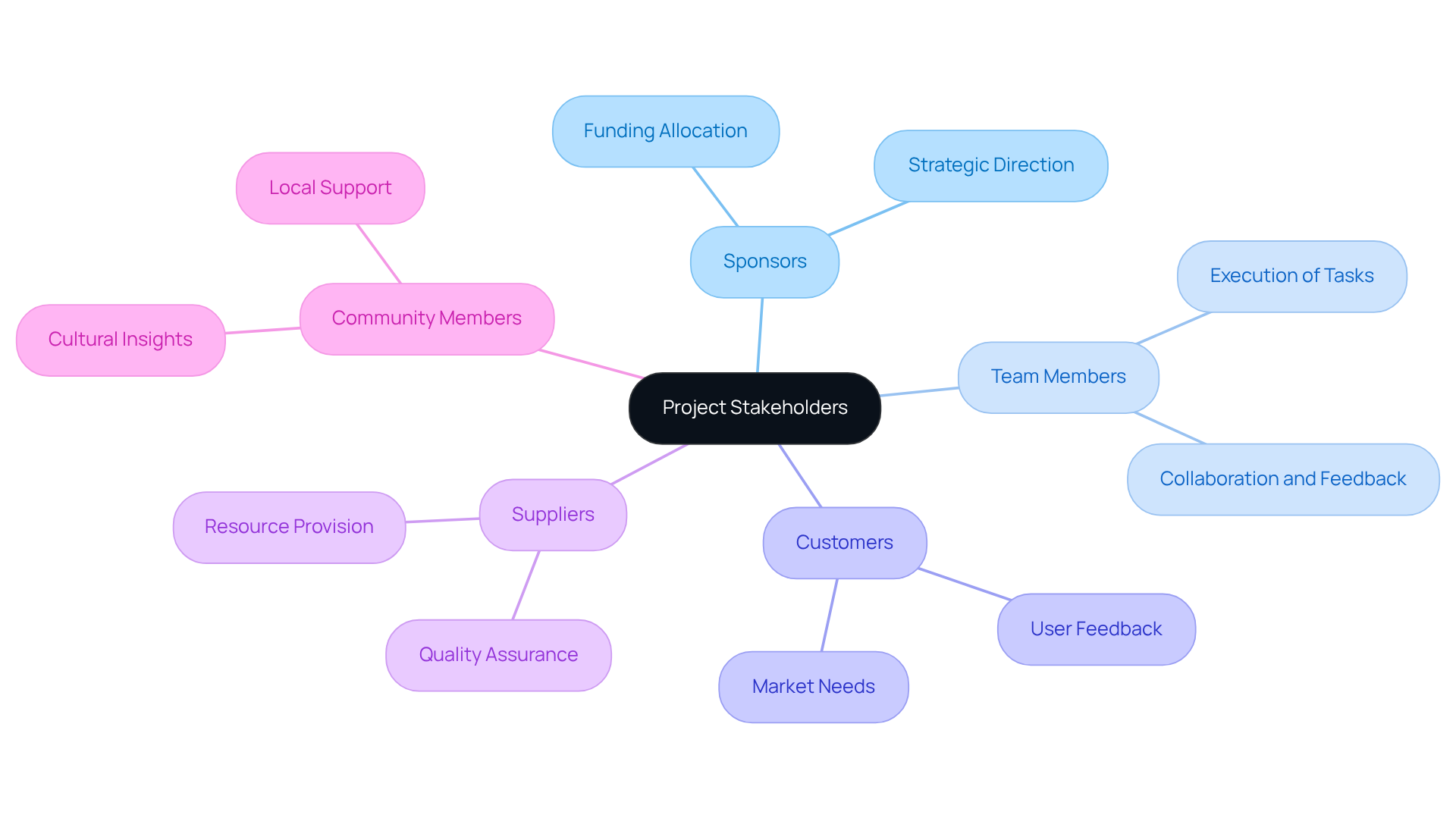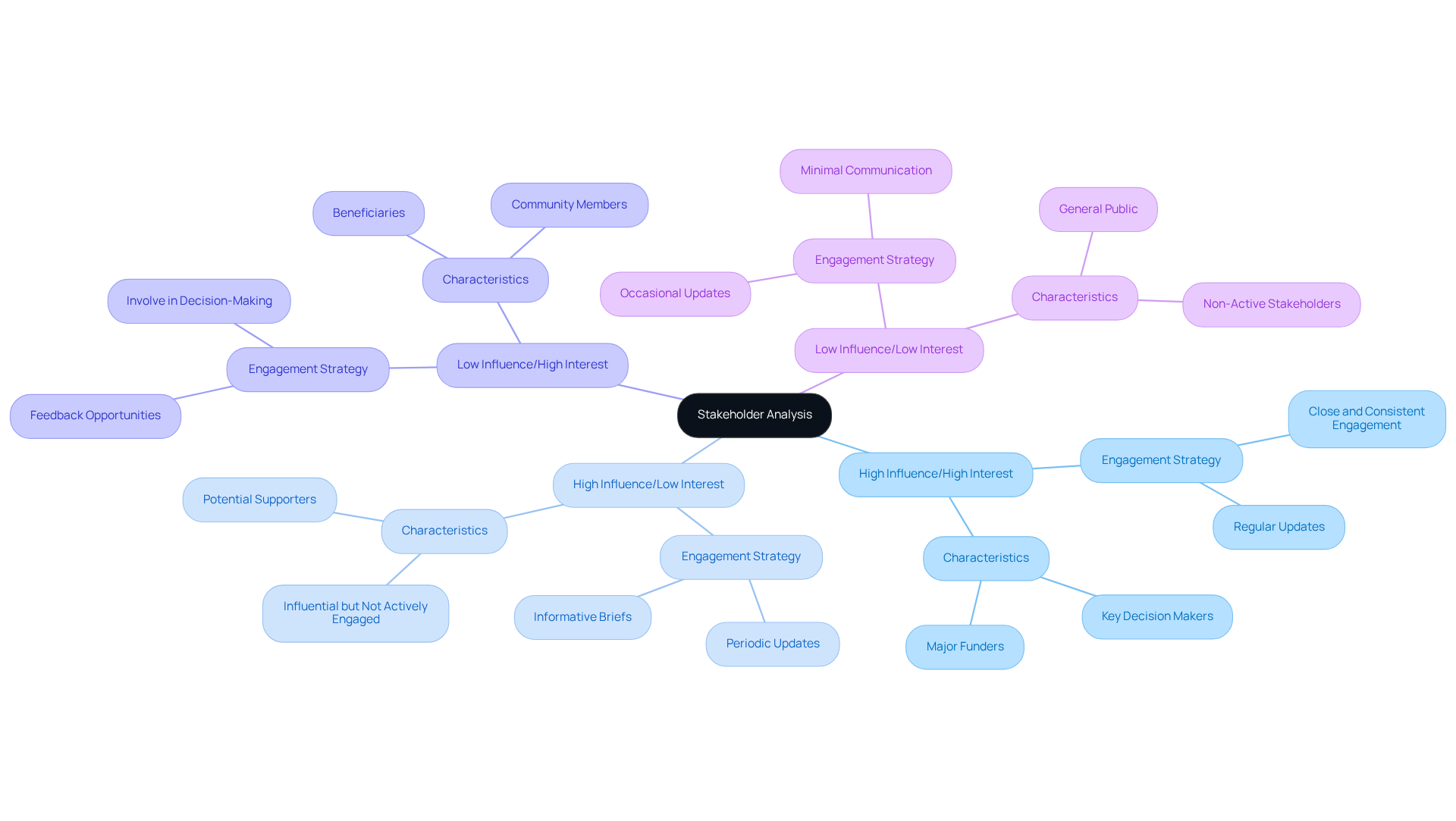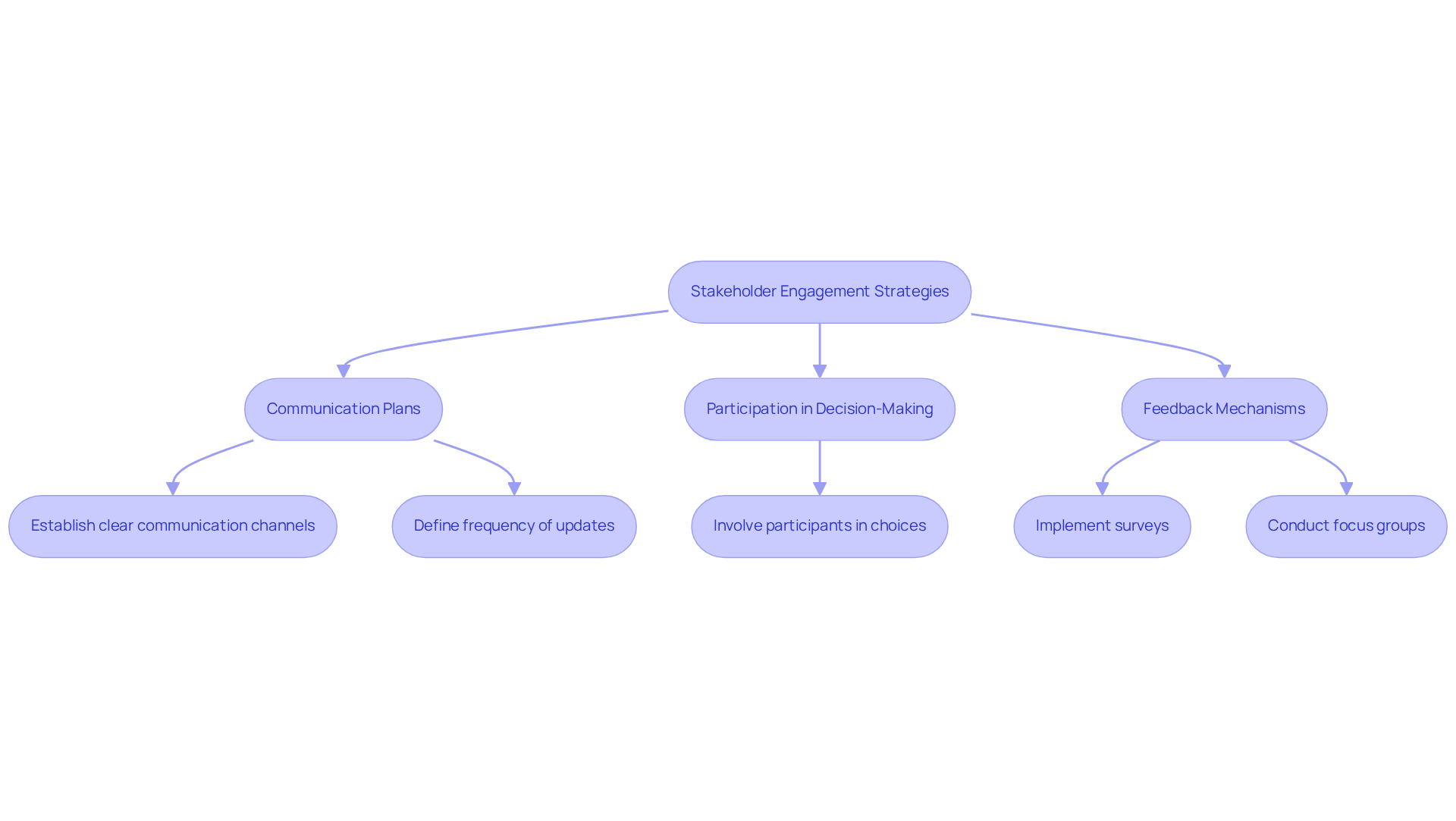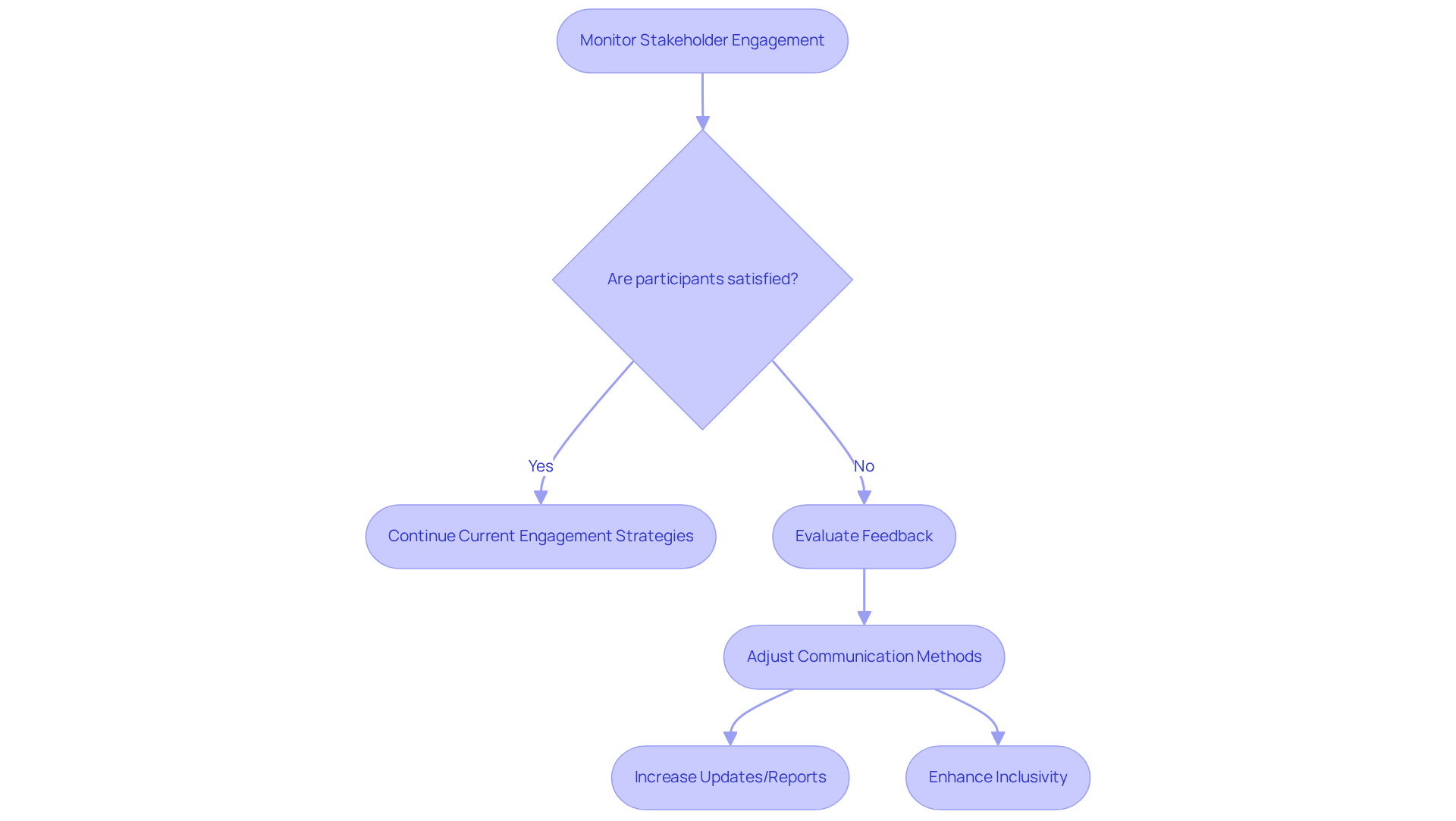Overview
Effective project stakeholder management is essential for achieving successful results. It involves identifying, analyzing, and engaging individuals or groups with a vested interest in a project's outcome.
- Tailored communication strategies
- Active participation in decision-making
- Ongoing monitoring of stakeholder engagement
These are crucial practices that foster collaboration. Moreover, these practices enhance project effectiveness. By implementing these strategies, project managers can create a more inclusive environment that drives better outcomes.
Introduction
Understanding the dynamics of project stakeholder management is crucial for any initiative's success. Stakeholders—ranging from sponsors to community members—wield significant influence over project outcomes. Their effective engagement can transform challenges into collaborative opportunities.
However, with diverse interests and varying levels of influence, how can project managers ensure they not only identify but also engage these stakeholders in a meaningful way?
This article delves into essential strategies for mastering stakeholder management, offering insights that can lead to enhanced collaboration and project success.
Define Project Stakeholders and Their Importance
Participants in the initiative encompass individuals or groups with a vested interest in its outcome, including:
- Sponsors
- Team members
- Customers
- Suppliers
- Community members
This is essential to the process of project stakeholder management. Their influence is crucial; interested parties can shape decisions, allocate resources, and ultimately determine success. Efficiently involving these stakeholders in the process of project stakeholder management not only enhances results but also fosters a collaborative environment where insights and feedback guide direction and execution.
For instance, during the 2010 Haiti earthquake, the American Red Cross adeptly engaged partners to manage the crisis, demonstrating how their support can be vital in overcoming challenges. In times of crisis, the process of project stakeholder management becomes even more critical, as it involves understanding and addressing the concerns and expectations of stakeholders, whose backing can significantly affect the ability to achieve objectives.
Effective communication strategies, such as transparency and active listening, are essential for building trust and ensuring participant commitment, ultimately leading to more favorable outcomes.

Identify and Analyze Stakeholders
To effectively recognize interested parties, it is essential to compile a comprehensive list of all individuals and groups who may be impacted by or have an influence on the process of project stakeholder management. Once these parties are identified, assess each one's level of interest and influence by employing a matrix of interests. This matrix categorizes participants into four distinct groups:
- High influence/high interest
- High influence/low interest
- Low influence/high interest
- Low influence/low interest
Understanding where each participant fits within this matrix is crucial for the process of project stakeholder management, as it allows for prioritizing engagement efforts and tailoring communication strategies to address their specific needs and concerns. For instance, parties with significant influence and strong interest should be engaged closely and consistently, whereas those with minimal influence may require less frequent updates.
As highlighted by The Community Tool Box, "Recognizing involved parties and addressing their concerns significantly increases the chances that your initiative will receive the community backing it requires and the suitable emphasis to be successful." This underscores the vital role of participant involvement in the process of project stakeholder management for achieving project success.
Furthermore, utilizing a persona template for customized communication can enhance the effectiveness of these interactions, ensuring that participants feel valued and understood. Integrating insights from case studies, such as the one on the Power-Interest Grid, can further illustrate the practical application of analytical tools, emphasizing the necessity for a strategic approach in managing relationships with involved parties.

Develop and Implement Stakeholder Engagement Strategies
Recognizing and examining interested parties is just the beginning; the next essential step in the process of project stakeholder management is to create customized engagement strategies tailored to each group. Consider the following approaches:
- Communication Plans: Establish clear communication channels and define the frequency of updates based on stakeholder preferences. High-interest parties may require regular meetings, while others might be satisfied with occasional newsletters. This structured approach can enhance message retention by up to 45%.
- Participation in Decision-Making: Involve essential participants in important choices to cultivate a sense of ownership and dedication to the initiative. This participation not only enhances connections but also results in improved outcomes, as organizations with involved participants are 78% more likely to succeed.
- Feedback Mechanisms: Implement opportunities for participants to provide feedback, such as surveys or focus groups. This guarantees that their opinions are acknowledged and valued, which can greatly enhance participant satisfaction and alignment with initiatives.
Regularly implementing these approaches throughout the lifecycle of the initiative is crucial for sustaining participant involvement and swiftly resolving any arising issues within the process of project stakeholder management. By doing so, organizations can mitigate risks and improve the overall success of their initiatives.

Monitor and Adjust Stakeholder Engagement Efforts
Effective oversight of participant involvement is essential for guaranteeing the success of any project, particularly in challenging settings like the Bogo region, where instability from Boko Haram has obstructed community-led initiatives, highlighting the significance of the process of project stakeholder management.
Consistent evaluations of your approaches can be accomplished through instruments such as surveys, feedback sessions, and performance metrics, which offer valuable insights into participant satisfaction and engagement levels. Given a 63 percent illiteracy rate in the area, it is crucial to customize communication methods to ensure all parties are informed. If feedback suggests that a key participant feels uninformed, it may be necessary to increase the frequency of updates or provide more detailed reports to address their concerns.
As observed by the Global Mapping and Environmental Monitoring NGO, "This process not only boosted the involvement of women in the planning phase but also in the execution of the approach," emphasizing the significance of inclusive participation.
Moreover, monitoring participant satisfaction metrics can assist in recognizing trends and areas for enhancement, enabling prompt modifications to engagement strategies. By proactively monitoring and adapting your efforts in the process of project stakeholder management, you can foster a supportive environment where stakeholders remain invested in the project's success, ultimately leading to better outcomes and enhanced collaboration.

Conclusion
Mastering the process of project stakeholder management is essential for ensuring project success. Engaging stakeholders—those individuals or groups with a vested interest in the project's outcome—creates a collaborative environment that can significantly influence decisions and resource allocation. By understanding their roles and implementing effective communication strategies, project managers can foster trust and commitment, ultimately leading to more favorable results.
The article outlines critical steps in stakeholder management, including:
- Identifying and analyzing stakeholders
- Developing tailored engagement strategies
- Continuously monitoring and adjusting these efforts
By employing tools such as interest-influence matrices and feedback mechanisms, project managers can prioritize engagement and ensure that all voices are heard. Real-world examples, such as the American Red Cross during the Haiti earthquake, illustrate the importance of stakeholder involvement in navigating challenges and achieving objectives.
In conclusion, the significance of effective project stakeholder management cannot be overstated. By actively engaging stakeholders and adapting strategies based on their feedback, organizations can create a supportive environment that enhances collaboration and drives project success. Embracing these best practices will not only improve outcomes but also empower stakeholders, ensuring that their insights and concerns are valued throughout the project lifecycle.
Frequently Asked Questions
What are project stakeholders?
Project stakeholders are individuals or groups that have a vested interest in the outcome of a project. This includes sponsors, team members, customers, suppliers, and community members.
Why are project stakeholders important?
Project stakeholders are crucial because they can influence decisions, allocate resources, and determine the overall success of a project. Their involvement enhances results and fosters a collaborative environment.
How can engaging stakeholders benefit a project?
Engaging stakeholders can lead to better project outcomes by incorporating their insights and feedback, which helps guide the direction and execution of the project.
Can you provide an example of effective stakeholder management?
An example of effective stakeholder management is the American Red Cross during the 2010 Haiti earthquake, where they engaged partners to manage the crisis, demonstrating the importance of stakeholder support in overcoming challenges.
What role does communication play in stakeholder management?
Effective communication strategies, such as transparency and active listening, are essential for building trust and ensuring participant commitment, which ultimately leads to more favorable project outcomes.
How does stakeholder management change in times of crisis?
In times of crisis, stakeholder management becomes even more critical as it involves understanding and addressing the concerns and expectations of stakeholders, whose support can significantly impact the ability to achieve project objectives.




